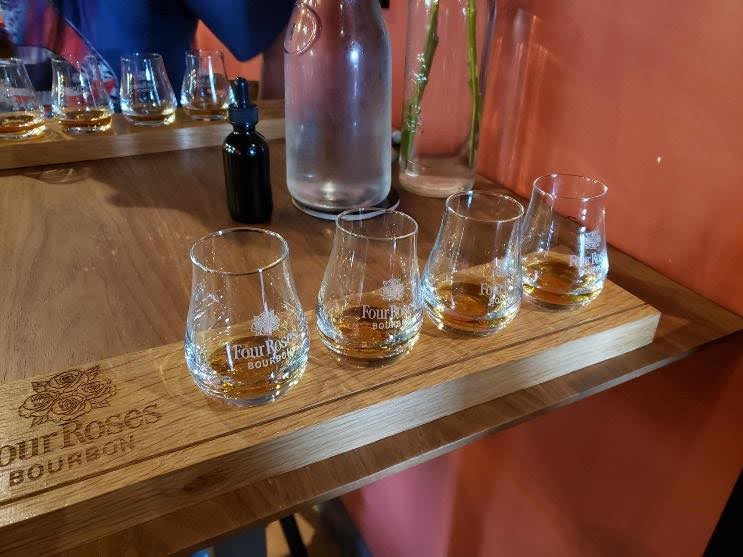Whiskey Wisdom: 21 Terms To Nerd Out To
Whiskey isn’t just a drink; it’s an adventure in a glass. It’s a journey through time and tradition that tickles your taste buds and warms your soul. Whether you’re a novice just starting to explore this fascinating world or a seasoned aficionado with a collection that would make a Scotsman weep, understanding the lingo is part of the fun. It’s like having the secret password to a club of connoisseurs who appreciate the artistry and passion poured into every bottle. So, buckle up, pour yourself a generous dram, and let’s dive into the delightful and sometimes quirky terms that will elevate your whiskey game to a whole new level. Cheers to discovering the magic behind the malt!

- Angel’s Share
This heavenly term refers to the portion of whiskey that evaporates from the cask during aging. As the whiskey matures in wooden barrels, a small amount seeps out, supposedly going to the angels. This loss, typically around 2-5% per year, is a natural part of the aging process and contributes to the unique character of each batch.
- Barrel Proof
Also known as cask strength, barrel proof whiskey is bottled directly from the barrel without dilution. This results in a higher alcohol content, often exceeding 50% ABV (alcohol by volume). For those who appreciate a bold and intense flavor, barrel proof whiskeys are a thrilling experience.

- Dram
A term for a small serving of whiskey, usually about 1.5 ounces. The term originates from the Scottish Gaelic word “drachm,” which was a unit of measure. Offering someone a dram is akin to inviting them to share a moment of warmth and camaraderie.
- Finish
The finish of a whiskey is the lingering taste left after you’ve swallowed it. A whiskey’s finish can vary widely, from short and sweet to long and spicy. Enthusiasts often savor this aspect, as it adds depth to the tasting experience and can reveal subtle flavors that weren’t immediately apparent.
- Mash Bill
The recipe for the grains used in whiskey production is called the mash bill. Typically, it includes a combination of barley, corn, rye, and wheat. The proportions of these grains significantly influence the flavor profile of the whiskey. For instance, a high-rye bourbon will have a spicier kick compared to one with more corn.
- Neat
Drinking whiskey neat means enjoying it straight from the bottle, without any mixers, ice, or water. This method allows you to fully appreciate the whiskey’s aroma and flavor in its purest form. It’s a preferred choice for many purists who want to experience the spirit as the distiller intended.
- Peat
Peat is partially decomposed plant material found in bogs, used as a fuel source to dry malted barley in some whiskey production, particularly in Scotland. Peat imparts a distinctive smoky flavor to the whiskey, beloved by fans of Islay single malts. The level of peatiness can range from a subtle hint to a full-on smoky punch.
- Single Malt
Single malt whiskey is made from malted barley and produced at a single distillery. This term is often associated with Scotch, but other countries, like Ireland and Japan, also produce exceptional single malts. The key here is the use of a single type of grain (barley) and the product coming from one distillery.

- Yeast
Yeast is the unsung hero of whiskey production. These microscopic organisms convert the sugars in the wort (liquid that is extracted from the mash) into alcohol and carbon dioxide during fermentation. Different strains of yeast can impart unique flavors and aromas, making it a vital ingredient in the whiskey-making process.

- Rickhouse
A rickhouse, or warehouse, is where barrels of whiskey are stored for aging. The location of a barrel within the rickhouse can affect the aging process due to variations in temperature and humidity. This contributes to the unique characteristics of each barrel, even within the same batch.
- Whiskey vs. Whisky
While both terms refer to the same spirit, the spelling difference generally denotes the country of origin. “Whiskey” with an “e” is used in the United States and Ireland, whereas “whisky” without the “e” is used in Scotland, Canada, and Japan. It’s a small but significant distinction that reflects the rich heritage of whiskey-making traditions around the world.
- Distillation
This is the process of heating the fermented liquid to separate alcohol from the water and other components. Distillation is essential in creating the strong, concentrated spirit that eventually becomes whiskey. It’s often done multiple times to achieve the desired purity and strength.
- Malt
Malt refers to barley or other grains that have been soaked, germinated, and dried to convert starches into fermentable sugars. Malted barley is a key ingredient in many types of whiskey, providing both fermentable sugars and distinctive flavors.
- Charring
Barrels used for aging whiskey are often charred on the inside. This process involves briefly exposing the wood to an open flame, creating a layer of char. This charred layer acts as a filter, removing impurities and adding rich flavors like caramel and vanilla to the whiskey.
- Blended Whiskey
A blend of different types of whiskeys from multiple distilleries, blended whiskey is crafted to achieve a consistent flavor. This category includes blends of malt and grain whiskeys, offering a versatile and approachable profile for a wide range of palates.
- Bonded Whiskey
Also known as Bottled-in-Bond, this term refers to a whiskey that meets specific legal requirements: it must be the product of one distillation season, by one distiller, at one distillery, and aged in a federally bonded warehouse for at least four years. It must be bottled at 100 proof (50% ABV). This designation ensures a certain standard of quality and authenticity.

- Pot Still
A traditional type of still used in the distillation of whiskey, the pot still is made of copper and has a distinctive shape with a wide, rounded base and a long, tapering neck. Pot stills are often used for producing richer, more complex whiskeys, such as those found in Scotch and Irish varieties.
- Proof
Proof is a measure of the alcohol content in a beverage, calculated as twice the ABV. For example, a whiskey with 50% ABV is 100 proof. This term is particularly important in the United States, where it is commonly used to indicate the strength of spirits.
- Nosing
Nosing refers to the act of smelling whiskey to appreciate its aroma. This step is crucial in the tasting process, as a significant portion of the flavor experience comes from the nose. Take your time to inhale deeply and identify the various scents before taking a sip.
- Legs
When you swirl whiskey in a glass, you might notice streaks running down the inside. These are called legs, and they can indicate the whiskey’s viscosity and alcohol content. Thick, slow-moving legs often suggest a richer, more robust whiskey.
- Age Statement
An age statement on a bottle of whiskey indicates the youngest whiskey in the blend. For example, a 12-year-old whiskey means that the youngest whiskey in the bottle has been aged for at least 12 years. This can give you an idea of the whiskey’s maturity and potential flavor profile.
Armed with these terms, you’re ready to dive deeper into the enchanting and flavorful world of whiskey. Picture yourself at a tasting event, confidently discussing the complexities of a single malt or the nuances of a barrel proof bourbon, impressing fellow enthusiasts with your newfound knowledge. Whether you’re savoring the angel’s share in a historic distillery in Kentucky or enjoying a dram by the fireside at home, these terms will enhance your appreciation and enjoyment of this storied spirit. So, pour yourself a dram, savor the angel’s share, and embark on a sensory journey through centuries of craftsmanship and tradition. Here’s to the legends in the rickhouses, the alchemy of yeast, and the smoky whispers of peat—cheers to the endless adventure that is whiskey! Sláinte!
LET’S START A CONVERSATION!
So, what did you think? I would love to know your thoughts, so comment below. You know I love conversation and will reply to you. As always, I want to thank you so much for taking the time to read this. Until the next Whiskey Wednesday, if you’re going to enjoy a little smoke & oak, just remember, “Life’s too short, enjoy the good stuff…” and do it responsibly!

Charles Ruth


